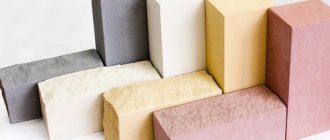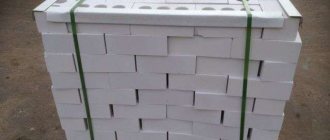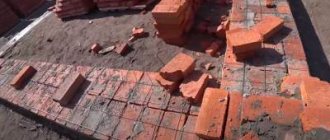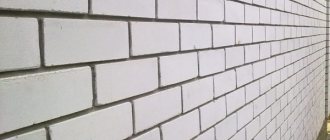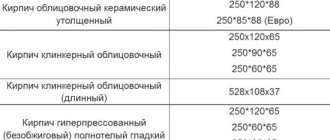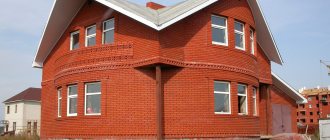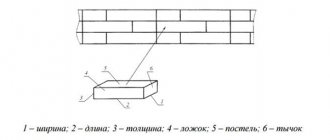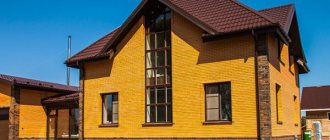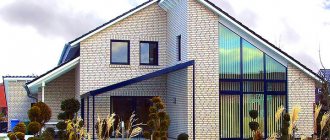Modern construction cannot do without white silicate brick. It stands out for its environmentally friendly characteristics, and consists of lime, sand and water. Sand-lime brick is popular in all European countries due to its combination of excellent characteristics.
These include: strength, accuracy in accordance with all geometric parameters described in GOST, affordable pricing and ease of installation. In addition, the size of white silicate brick is considered the most optimal among all analogues.
Linear dimensions of sand-lime brick
Sand-lime bricks are divided according to their sizes into 3 main types. These types are regulated by GOST, and the sizes of sand-lime bricks are standard:
- Single (size 250x120x65 mm);
- One and a half (have a size of 250x120x88 mm);
- Double (130x176x206 mm).
Sand-lime bricks whose dimensions do not comply with GOST, and which do not have a standard size and shape, are often produced abroad. Some of them are produced for specific sections of the structure (arches).
Thickened and one-and-a-half silicate bricks are used to speed up work and reduce the consumption of cement mortar. The main criterion for the efficiency of one and a half bricks is the number of bricks per cubic meter. For one and a half, this figure is 314 pieces, while for single, 414 pieces. In our camp, one-and-a-half (250x120x88 mm) sand-lime bricks are most often used. The weight of silicate one-and-a-half bricks is about 4-4.2 kg, depending on its type (hollow or solid).
Hollow ones have less weight (15-20% less than full-bodied ones). Reducing weight reduces pressure on the foundation and also improves thermal insulation characteristics. The air in the voids can further reduce the freezing of walls, while the strength of the wall does not decrease. Solid is used on building facades if installation of ventilated facades is required.
Weight and size of white sand-lime brick according to GOST
Sand-lime brick is made in the form of a rectangle according to a strictly defined shape and size. The standard dimensions of white sand-lime brick are regulated according to GOST and do not allow any deviations in the manufacturing process of both the molds for its production and the building material itself. Depending on the type and purpose - different sizes and weights.
The parameters of a single one are 250x120x65 mm , weight about 3.5 kilograms. The weight of sand-lime brick largely depends on its characteristics - hollow brick weighs significantly less than solid brick, as does low-density brick.
According to technical regulations, there can be 7 types. Hollow has less weight and cost compared to denser products of the same type. One-and-a-half or thickened full-bodied has dimensions of 250x120x88 mm and an approximate weight of 5 kg. Bricks of dimensions 250x120x138 mm , called double and weighing on average 7–8 kilograms, have found quite widespread use.
In industrial construction, it is customary to take into account not the mass of each brick, but the total specific gravity of a cubic meter of the entire masonry, including the glue and mortar used. This allows you to calculate the total load on the foundation of the building and make the necessary adjustments during the construction process. Depending on the type of brick used, size and density, thickness of the mortar, the specific gravity of a cubic meter varies from 670 kg/cub.m to 2100 kg/cub.m.
What types of white brick are there?
The consumer can purchase this type of building material in two variations:
- solid brick;
- hollow appearance of brick. In this option, there are special voids on the surface of the construction product, which are located perpendicularly. Such voids can be end-to-end or non-through.
White silicate products are made in different sizes. Also, brick does not always remain white; dyes can change its shade. The ideal shape of the product allows you to easily change the color of the product, so its color can be white, gray, pink.
The different relief of the material helps to transform standard buildings, giving walls or partitions the appearance of natural processed stone. Thanks to this, the appearance of the facade is significantly improved, and you can create an impressive design.
Masonry
Before laying white silicate briquettes, pay attention to the following advice from repair teams:
- it is necessary to leave a gap between the surface of the structure and the masonry, which will later become the basis for the ventilation system. Its permissible width is 60cm ;
- seam size no more than 13mm;
Masonry
- The laying mixture should be as thick as possible. White building material strongly absorbs moisture;
- Immediately after the construction of the supporting structure or internal partition, the bricks are treated with special chemical elements that repel moisture. Thanks to it, it becomes easier to wash the white surface and dust does not settle on it as much.
Classification of silicate blocks
According to GOST 379-95, bricks are divided into groups depending on their application, dimensions and physical properties
- By purpose:
- Facial. This type is chosen for finishing the facade. The blocks are available in a wide range of colors and different textures (for example, natural stone). Smooth facing brick has straight, clear edges and flat edges; it can also serve as a structural material.
- By structure:
- full-bodied;
- hollow.
- By porosity:
- dense (above 1500 kg/m3);
- porous (less than 1500 kg/m3).
- In terms of strength (it is expressed in kgf/cm2) – 8 grades: 75; 100; 125; 150; 175; 200; 250; 300.
- In terms of frost resistance (expressed in the number of freezing and thawing cycles) - for ordinary blocks F15, F25, F35, F50, and for facing blocks - at least F25.
- By size:
- single – 250 x 120 x 65 mm;
- one-and-a-half (thickened) – 250 x 120 x 88 mm;
- double – 250 x 120 x 138.
Clinker brick
Clinker brick is another special type of ceramic brick. In its manufacture, a special type of clay is used - refractory shale. The molded blocks are fired at a very high temperature - 1200°C. As a result of this processing, the clay acquires the properties of ceramics, the color ranging from dark red to rich brown.
Clinker brick has very high strength and abrasion resistance. You can use it to pave roads or decorate porches. And they will serve for centuries. The surface of the clinker is flat, smooth, shiny. This allows it to be used also as a finishing brick - for finishing facades, laying pillars, etc.
Types and sizes of clinker bricks from one of the companies
The shape and size of clinker bricks can be very different - there are a lot of them, since there are not only standard ones - in the form of a parallelepiped, but also with beveled at different angles, rounded edges.
Brick mass and density
Silicate block structure
Sand-lime brick is a building material that has a fairly high density and therefore has a fairly high specific gravity.
The main reason is the substances from which the brick is made, as well as the features of its manufacturing technology:
- The basis of any sand-lime brick (both solid and hollow) is sand purified from foreign impurities and sifted. The sand fraction accounts for 85 to 90% of the total composition (depending on the brand).
- To ensure the strongest possible connection of sand particles with each other, lime is used. When preparing silicate raw materials for raw production, quicklime is poured into the sand, which is slaked with water or steam during the mixing process.
- The mixture may also include expanded clay sand as additional components. Since this substance has a low density, brands with a high content of expanded clay are lighter and at the same time retain heat better.
- Pigments and other substances that are added to the silicate mixture to improve its characteristics do not have a particular effect on the mass of the material.
The quality of pressing of the workpiece is of great importance in the formation of the mass of one block. As a rule, a sand-lime mixture with additives is pressed under a specific pressure of 150-200 kgf/cm2. The force created by the hydraulic press “squeezes out” almost all the air from the workpiece, and the specific gravity of the finished product increases.
Mass and volumetric weight
Experts point out that when planning the structure and developing a building project, a key role is played not only by the weight of one sand-lime brick, but also by its volumetric weight, i.e. mass to volume ratio
Most varieties of this material on the market are characterized by the following volumetric mass indicators:
- For full-bodied - 1900 - 2000 kg/m3.
- For hollow bricks – 1600-1800 kg/m3.
In addition to the weight of the brick itself, when calculating the mass (especially if you do it yourself), you must also take into account how much the brickwork weighs as a whole.
The instructions recommend using the following figures as a basis:
- Regular masonry – 1400 – 1900 kg/m3.
- Rubble masonry – up to 2200 kg/m3.
Using these numbers, you can approximately calculate the load to which the base will be subjected and draw appropriate conclusions. It should be borne in mind that sand-lime brick is a fairly heavy material, so you should not be surprised if the calculations show very significant figures.
For the same reason, specialists rarely use silicate building materials in the construction of high-rise buildings. But in low-rise private construction, where the load on the supporting structure is not very large, even solid brick will be quite appropriate.
Production
White silicate brick is made from sand and potassium oxide. Only here you need to follow the 9:1 formula.
The material is then pressed and placed in an autoclave heating device, designed to heat a variety of materials.
Autoclave
If you pay attention to state standards, white brick has a parallelepiped shape . Moreover, its planes are smooth and its angles are right. Silicate bars are marketed in the form of solid and hollow briquettes. On the market you can find single, double, and one-and-a-half analogues.
The difference in sizes that were described above can be explained by the thermal conductivity of the material (its ability to conduct heat). The higher the density, the higher the thermal conductivity. Therefore, the choice of one or another brick should be based on a goal.
You need to decide whether it will be used for external structures, floors, or whether it will cover the floor. The purpose of use is based on the requirements for technical parameters.
For example, strength can be determined by the marking “M”: 200, 150, 125, 100, 75, where the letter indicates the degree of load per 1 m2 of material.
You can also highlight other positive characteristics of sand-lime brick. These include its correct shape, affordable price, maximum strength, and fire resistance. In addition, there is increased sound insulation and therefore such bars are difficult to replace during the construction of indoor partitions.
When white building material is used as cladding for the facade of houses and buildings, indicators such as moisture absorption are taken into account. it must be at least 6 percent.
Facade
Acceptable characteristics: strength - 15-20 MPa, body weight per unit volume - 1300 kg/m3, frost resistance 30-50 cycles, in other words, how many cycles of temperature fluctuations can the material withstand (for cold regions).
Weaknesses of white brick
However, despite all the advantages that convince us to use white brick for construction, a few words should be said about its disadvantages.
One of the main ones, which most often becomes an obstacle to its use as the main building material, is its insufficient heat-saving ability. Ceramic brick maintains the set temperature inside the house much better. However, by using hollow bricks for masonry, this drawback can be corrected. The voids in the body of the product create a higher-quality energy-saving wall. Manufacturers make three types of bricks with voids:
- 15% – 3 holes;
- 25% – 11 holes;
- 31% – 14 holes.
The percentage of voids affects how much a white brick weighs and how the wall will retain heat. If during laying the mortar clogs the holes, then, in addition to greater consumption of the cement composition, clogging of voids will occur. To avoid this effect, experienced foremen advise choosing bricks with smaller holes.
Another disadvantage of sand-lime brick is its hygroscopicity. The ability to absorb moisture does not allow it to be used for building foundations, finishing basements and rooms with high humidity. A special plinth brick is best suited for this.
How to make white sand-lime brick
The composition of sand-lime brick consists of approximately ninety percent sand and ten percent lime. Some manufacturers, by reducing the amount of lime, add some chemical elements.
A mixture of sand and lime, which is pre-fired, is placed in a special autoclave. Quartz sand (formula) and water are added there, which, under the influence of pressure and high temperatures, forms a silicate compound.
Autoclave
Pigments can be added to this mixture; they are resistant to atmospheric changes and the appearance of alkali. Today, many manufacturers widely use a variety of dyes, which give the material a wide range of different shades.
The composition of sand-lime brick also includes various components, due to which it becomes as durable as possible and resistant to sub-zero temperatures. Here is the texture of white brick. But, not surprisingly, white sand-lime brick is considered the most popular.
How much does sand-lime brick weigh?
Sand-lime brick belongs to the category of artificial building materials for the construction of vertical enclosing structures. The characteristics are excellent, the scope of application is wide, but do not forget that the type of foundation or supporting elements depends on such a parameter as the mass of white brick. Therefore, even for the simplest calculations you need to know the weight.
Types and characteristics
White brick is produced using a non-firing method from a mixture of lime binder, silica filler (quartz sand, fly ash, sludge, etc.) and a small amount of water to moisten the mixture. Under production conditions, raw materials are pressed and autoclaved. Due to this, the finished block gains the required parameters:
1. Compressive strength is marked as M75-M300.
2. Thermal conductivity – up to 0.87 W/m*K.
3. Frost resistance: withstands from 15 to 50 complete freeze-thaw cycles when completely immersed in water.
4. Density: porous or light up to 1500 kg/m³. Products with an index exceeding this indicator are called dense.
5. Water absorption – 6-16%.
The factories produce silicate blocks of the following dimensions:
- Single: 250x120x65 mm.
- One and a half or thickened: 250x12x88.
- Double: 250x120x103.
- Embossed: 250x90x65.
According to the area of application, a distinction is made between working or ordinary bricks and facing bricks. The latter is used for finishing facades, foundations, basements, and fences.
The structure for all sizes is typical:
- solid or monolithic product;
- hollow products, with a void content of up to 15% (3-hollow), 25% (11-hollow) and 31% (14-hollow).
White brick produced in accordance with GOST 379-95 “Silicate bricks and stones” must have a standard mass according to the table below.
The data from the table is adjusted for the weight of auxiliary materials. That is, for example, the weight of one one-and-a-half solid sand-lime brick, made according to the basic recipe from lime and sand, is 4.2 kg/piece. The total weight of the building material laid on a Euro pallet is 840 kg, but the pallet itself, protective film and fixing belts are added to this. Accordingly, the cargo prepared for transportation will weigh approximately 846 kg.
The weight of a hollow silicate block 250x120x88 is less than its solid counterpart precisely due to the cracks, but during the construction process they will be filled with mortar, so the total mass of the masonry will increase significantly. This must also be taken into account when calculating the project plan.
Before purchasing, you need to carefully examine the offered product. The surface must be hard, smooth, without chips, hewn corners, cracks and cavities. If the product crumbles in your hand or is slightly dented, it means that it was over-dried or under-dried, so it is not suitable for building walls - it will quickly collapse.
Pros and cons of sand-lime brick
Let's start with the biggest advantages. Sand-lime brick has very good geometry and high dimensional accuracy. This makes laying much easier. Second point: good quality material looks very decent. The most common color is white. Even if you use it and take a dark solution, it already looks good. The addition of pigment and fillers allows you to achieve a wide range of colors. There are also types with a decorative surface.
Sand-lime brick has its pros and cons, but they have built from it before and are building from it now
A significant plus is high strength and low price. A good sand-lime brick is approximately 50-60% cheaper than a similar ceramic brick . If you compare finishing silicate and clinker, the difference will be even more significant. In general, a worthy option both for the construction of walls and partitions, and for finishing.
Flaws
Let's look at the disadvantages that sand-lime brick has:
- High water absorption. GOST standards for silicate and ceramic bricks determine only the lower limit of water absorption. Moreover, it is the same: moisture absorption by silicate and ceramics should be no lower than 6%. There is no upper limit. In fact, for silicate products this figure is in the range of 8-16%. The situation with ceramics is at least no better. In fact, 10-18% is not that much. Moreover, silicate tolerates getting wet without much damage, and absorbs and releases moisture equally easily. Otherwise, all the garages, which are mostly built from this material, would have a very deplorable appearance. And they look very good, although in garages made of sand-lime bricks the material is used in very harsh conditions.
Any plant provides complete information for each type of product
- Heavy. If we talk about solid sand-lime brick, then the standard one weighs about 4 kg ±300 g (depending on density). If we compare it with ceramics of the same size, it is 3.4-3.8 kg. A little less, but not critical.
- It's worse to plaster. This is objective, but you can fight it. First, you need to choose the right plaster, taking into account the fact that it will be covered with silicate, which contains, albeit slaked, lime. Secondly, smooth walls actually hold the plaster worse. This is leveled out by the use of plaster mesh.
In general, the ideal building material has never been invented. All have their drawbacks and silicate is no exception. But he's not that bad. The best thing is that the technology is simple. If you stick to it, quality is guaranteed. And good sand-lime brick does not lose strength over time. Look at houses built decades ago - there is no efflorescence on them. Yes, the walls have become gray, but they are not crumbling or collapsing. Yes, it is “not too warm,” but according to modern standards, ceramic brick also requires insulation. So this is also not an argument. In general, the situation is ambiguous. As always, it is important to choose quality material, and this is perhaps the most difficult thing.
Main varieties and characteristics
The process of creating sand-lime brick is fundamentally different from the method of manufacturing its ceramic analogues - in particular, different raw materials are used, which are processed in a different way.
To make it, a mixture of siliceous filler (quartz sand), siliceous binder (fly ash, sludge, etc.) and process water is used (it is needed to moisten the mixture, it is used in small quantities). The mixture is pressed and then processed in an autoclave.
Sand-lime brick in an autoclave
The finished white brick is characterized by the following parameters:
| No. | Name | Meaning |
| 1 | Thermal conductivity level | ≤0.87 W/m*K |
| 2 | Frost resistance | When completely immersed in water, it can withstand freezing followed by thawing (full cycles) of at least 15 and up to 50 |
| 3 | Water absorption | From 6% to 16% |
| 4 | Compressive strength | The range of possible brands varies from M75 to M300 |
If we talk about the scope of application of such structural material, then two main varieties are currently produced:
- ordinary (sometimes called a worker) - used directly for constructing vertical enclosing structures;
- facing - as the name suggests, it is mainly used for finishing work: it is used to cover facades, fences, as well as foundations and basement floors.
In addition, from the point of view of geometric characteristics, there are four types of such products:
| Variety | Length, cm | Width, cm | Thickness, cm |
| single | 25 | 12 | 6,5 |
| One and a half (sometimes called thickened) | 25 | 12 | 8,8 |
| double | 25 | 12 | 10,3 |
| raised | 25 | 9 | 6,5 |
- three-hollow (void content is 15%);
- eleven-hollow (void content – 25%);
- fourteen-void (contains about 31% voids).
Characteristics of building bricks
Let's pay attention to the white sand-lime brick. Its dimensions are 25x12x6.5 cm , and it stands out with the following characteristics:
- strength – 150 kgf/cm;
- percentage of moisture absorption - 9.4;
- weight – 3.2 kilograms;
- frost resistance - 35.
Characteristic
If we make comparisons, the hollow one-and-a-half bar 25x12x8.8 has the same characteristics. the weight will be approximately 0.8 kg more.
Hollow one and a half
The weight of this brick will be approximately 0.8 kg more than that of a single brick.
Weight of different types
Select one-and-a-half or single material
Thickened silicate brick, sized 250x120x88, previously officially called one-and-a-half brick, is gradually displacing its popular brother, single brick - 250x120x65, from the building materials market. The reason for the changes taking place, as experts explain, is the desire of the population to combine completely opposite things - strength, low cost of material and acceptable ability to retain heat.
Let's compare the advantages and disadvantages of ordinary sand-lime brick, with dimensions 250x120x65, and thickened brick, with dimensions 250x120x88:
The simplest calculation shows that the number of thickened pieces is approximately 1.35 times less than the number of standard sizes, which means that the walls of the house will be built faster; It is unlikely that you will be able to win on paying masons when laying a block of 250x120x88, the number of pieces of material is less and the weight is greater
The same can be said about transportation costs; for carriers, it is not the number of pieces of silicate block that is important, but the weight of the cargo. Regardless of the type of silicate brick being laid, the total volume of the walls will remain the same and the total weight of the sand-lime brick will not change. Benefits can arise if you use silicate material with dimensions of 250x120x88 with artificial voids
With a standard cavity volume of 30-40%, its weight will be identical to a single solid block, and its thermal insulation properties will be 40-50% higher. The cost of thickened sand-lime brick 250x120x88 is at least 20% higher than its single counterpart; according to builders, it does not always look more attractive in brickwork due to its size.
The last factor is a matter of personal preference of the customer. Manufacturers of one-and-a-half bricks compensated for the last drawback by releasing special options with decorative elements and cladding. Colored versions made of silicate material, painted with mineral compounds in black, blue, and white, have appeared on the market. Particularly popular is the coloring of ceramic fiery red stone. There are options for a silicate block with a beautiful chipped front surface, imitation of natural stone material or debarked logs.
Advantages and disadvantages
Before deciding on the choice of material for construction, it is worth studying all its advantages :
- high sound insulation - in rooms made of silicate material no extraneous sounds will be heard;
- efflorescence never appears on it : a white salt coating that appears on bricks made of other materials;
- resistance to low temperatures allows it to be used in regions with constant frosts;
- by using hollow types you can reduce the pressure on the foundation and lighten the weight of the entire building;
- The natural components included in the composition make the brick environmentally friendly ;
- silicate stone is much lower in cost , unlike other analogues.
The main disadvantage is its high moisture absorption; in damp rooms this material begins to deteriorate. This problem can be partially solved by treating the walls with a special waterproofing compound , thus reducing the hygroscopicity of silicate stone. It is worth noting the increased thermal conductivity , which means that this artificial stone easily gives off heat without retaining it, so additional insulation of the building is necessary .
physical characteristics
Let us consider the important characteristics of sand-lime brick in construction. The first component is the density of the finished product. Without going into details (anyone can find them on their own in GOST 379 2015), materials are divided into dense - density more than 1500 kg/cubic meter and porous, less than 1500 kg/cubic meter. Based on strength, they are divided into 6 classes, marked with the letter M and a digital designation from 75 to 300.
The characteristic determines the tensile/compressive strength of the brick and the compressive strength of the stone. When saturated with water, the strength of the product decreases significantly. The next component is frost resistance F - the average number of defrosting/freezing cycles of the product, after these cycles the material loses its professional suitability.
For internal walls and partitions the indicator is within 15 cycles, for external walls, columns and other products in direct contact with the external environment - 100 cycles. The addition of modern chemical additives allows you to increase F several times, which affects the environmental friendliness of the product.
The thermal conductivity of the product depends on the density and type of execution; The average thermal conductivity of a hollow stone is 0.55–0.8 W/mS; for a solid one it is much higher – 0.67–0.89 W/mS. The moisture absorption of the product is quite high, according to GOST standards it should not exceed 6%, but in fact it is twice as high - up to 12%. Depends on the porosity of the material.
Characteristics and standard dimensions according to GOST: thickness, width, length
There are many companies in European countries that produce sand-lime bricks. The price of their products is several times lower than other analogues, and they also stand out for their durability.
Sand-lime brick with a strength of one hundred to one hundred and fifty can be hollow or solid. Materials without a cavity are used when laying partitions of buildings, even for load-bearing structures.
However, in terms of versatility of use, they can be significantly inferior to ceramic analogues.
But the sound insulation performance of sand-lime brick is significantly better than that of ceramic brick. Hollow bricks retain all the qualities of their solid counterpart. At the same time, it is lighter, which has a positive effect on reducing pressure on the base.
Characteristic
In addition, the insignificant heat conductivity of such bricks makes it possible to build the thinnest possible walls, where the thermal insulation characteristics are not lost. One-and-a-half white silicate brick is a fairly popular material among builders; its dimensions are 25x12x8.8 cm.
To lay a square meter of area you will need more than three hundred and seventy pieces. But if only one stone needs to be used for masonry, then their number will increase to five hundred pieces.
For euro bricks the following dimensions correspond to 25x8.5x6.5 cm.
Euro
When arranging the arch and vault, it is rational to purchase wedge-shaped white sand-lime brick.
Its parameters:
- end part: 23x11.4x6.5/5.5 (SH-22), 23x11.4x6.5/4.5 (SH-23);
- rib wedge: 23x11.4x6.5/5.5 (SH -44), 23x11.4x6.5/4.5 (SH -45).
End and rib wedge
Properties of silicate material 250x120x88
The properties of silicate material 250x120x88 are higher than single and even ceramic ones. Before comparing the 250x120x88 brick with its single counterpart, let us explain why one-and-a-half silicate material has certain advantages over a ceramic block.
Problems of a ceramic competitor
The quality of ceramic stone depends 80% on the composition of the clay from which it is baked, and 20% on manufacturing technology or the level of technological sophistication of the process. A high level of production depends on the availability of expensive modern equipment, which in modern conditions is affordable only for large and serious production. But modern powerful deposits of high-quality clay have either been worked out or are being refined after the fact. The remainder are small and scattered deposits, with a mass of foreign inclusions of unsuitable clays. Therefore, the quality of bricks that have previously proven themselves in the market can suddenly be “degraded” to the limit.
Unlike ceramics, silicate material requires only high-quality cleaning; it is obtained artificially or synthetically, its quality is stable. Moreover, modern methods make it possible to significantly increase the density of the silicate mixture and increase the number of porous cavities, making it “openwork”. GOST for sand-lime brick 250x120x88 does not limit the manufacturer in this matter, as long as the wall remains at least 10 mm and the strength corresponds to the brand.
Where to use single and where to use one and a half silicate bricks
First of all, the parameters of sand-lime brick 250x120x88 allow you to comfortably take the material and lay it in the masonry with one hand. The strength and length of an adult's fingers is sufficient, but at the limit of capabilities. It is even more difficult to do this in canvas or textile mittens. The weight of a solid one-and-a-half brick 250x120x88 is rather large - 4.3 kg. Therefore, it is difficult to work with it, although the seams are thinner and smoother.
From the practice of laying sand-lime bricks it has long been established:
- One-and-a-half brick 250x12x88 is successfully used in high-rise and low-rise buildings with a wall thickness of more than 50 cm;
- When choosing a brick for a specific masonry thickness, one proceeds, first of all, from the need to avoid excess wall thickness due to the large size of the brick and the excess number of rows due to the small size of a single brick;
- The outer row of silicate bricks 250x12x88 should be hollow and, better, facing; if the wall made of silicate stone does not have additional thermal insulation, then the entire masonry is made with silicate material 205x120x88, if strength conditions allow;
- Internal partitions and supporting structures are made only from single solid material.
For quick laying, you only need a hollow one-and-a-half block 250x120x88. Its weight varies depending on the density and number of voids from 3.5 to 4.1 kg.
Purpose of various models
Brick has different types of division. According to the type of material from which the brick is made, they are divided into:
- Red or ceramic is a universal material used for the construction of structures for various purposes. The manufacturing technology is simple and inexpensive: clay pressed into briquettes is fired and cooled. Widely used in the construction of fundamental structures, walls, partitions. Often used in the construction of high, strong and durable fences. The ceramic type has different markings - 75, 100, 120, 150, 200, 250 and 300. The marking is an indicator of the unit's ability to withstand a certain pressure.
- White or silicate - production is based on silicates. Silicate brick is considered less durable than red brick. But it is softer and more pliable, and has lightness. The versatility of white sand-lime brick is much less than that of the standard type. Used for the construction of walls and partitions. The use of white brick does not apply to the construction of foundations and fireplaces.
According to purpose, it is divided into 4 types:
- Private - provides operational functions for masonry.
- Clinker - considered a durable type, water absorption is practically absent. In aggressive environments it is used to build houses, as it can withstand terrible weather conditions. Also used as a decorative material.
- Fireclay or fireproof - in everyday life, units marked Ш are used, which have different dimensions.
- Facing - is divided into several subtypes: chopped, smooth, imitating wild stone. Has a wide selection of sizes.
Additional forms
There are 2 types of brick shapes: rectangular and wedge-shaped. This form is used when laying semicircular vaults and arches with different radii of curvature. Decorative or facing bricks are ideal masonry materials for constructing external walls and reproducing interior decoration.
Why are the length and width always the same - 250x120 mm? The height of the building material in question may vary. The silicate one-and-a-half brick has dimensions of 250x120x88 mm. Such changes are important for the convenient use of materials during masonry.
This is the kind of brick that fits easily in the hand, so it is convenient to place it
And since most of the work during the construction of a home is performed by people, it is important to create materials that are as easy to use as possible for them. The standard size of white sand-lime brick simplifies the laying of walls and partitions
When building a house, it is important to know what types of materials can be used for the foundation, and what types can be used to build walls and partitions between rooms. That is why before constructing buildings it is important to study the properties of a particular type of material
Not all bricks are suitable for exterior cladding of a house and construction of a foundation.
Sand-lime brick is one of the most sought-after and popular building materials. It is widely used for the construction of partitions and load-bearing walls of buildings. Therefore, the question often arises about the size of sand-lime brick.
What size is white sand-lime brick?
Sand-lime brick must have not only certain technical characteristics, but also have a specific size, shape, etc.
So, in order to meet the requirements of GOST 379-69, sand-lime brick must have the shape of a parallelepiped, even, smooth edges, right angles and sharp edges. Sand-lime bricks are produced solid and hollow.
Double, one-and-a-half and single silicate bricks are used in construction. Accordingly, their sizes differ.
So, the standard size of a single white sand-lime brick is: 250X120X65, where 250 is the length, 120 is the width and 65 mm is the thickness.
The standard size of one-and-a-half silicate bricks: 250X120X88, where 250 is the length, 120 is the width and 88 mm is the thickness.
Standard size of double white sand-lime brick: 250X120X138, where 250 is length, 120 is width and 138 mm is thickness.
In construction, one-and-a-half silicate bricks are always popular, the dimensions of which allow the construction of houses at an accelerated pace. The material attracts developers with its durability, reliability, and versatility - it is used for the construction of internal and external walls (load-bearing and self-supporting), arches, and columns. Knowing the dimensions of the brick, you can easily calculate how much there is in a cubic meter of masonry and the total need for construction.
Properties, technical specifications
Silicate building stone is made by autoclave pressing a mixture of lime (90%), quartz sand (10%), a minimum amount of modifiers, and water. The finished product has high performance qualities.
- Thermal conductivity is 0.56 W/mOS, and that of masonry made from it is 0.69 W/mOS. This is less than that of red ceramic brick, so it is advisable to construct facades using the silicate version;
- Density: solid – 1900 kg/m3, hollow – on average 1300 kg/m3;
- Water absorption – 6 – 13%. Due to its crystalline structure, the material absorbs and quickly releases moisture, so the likelihood of cracks appearing is lower than in walls made of ceramic bricks;
- Compressive and bending strength - according to this indicator, solid sand-lime brick is divided into 6 groups: 75, 100, 125, 150, 200, 250 kg/cm2. The most popular grade is 150. The strength of hollow brick is 15 – 50 kg/cm2;
- Frost resistance – 15, 25 and 35 cycles;
- A high degree of sound insulation is an advantage used in the construction of interior walls;
- The size of one and a half silicate white brick is 250 x 120 x 88 mm;
- Weight: full-bodied – 5 kg; hollow – 3.5 kg.
When constructing stoves and fireplaces, silicate products are not used, as they are destroyed at high temperatures. In addition, they cannot be used for foundations and plinths, since groundwater contains caustic salts of sulfurous acid that decompose silicates.
Standard sizes and dimensions of ordinary white brick - length, height, width, weight
White brick can have the following dimensions:
- 25x12x6.5 – This is the size of a single;
Single
- 25x12x8.8 - one and a half. Here is its size.
One and a half
We can conclude that the size of the standard white sand-lime brick is not much different from the thickened and one-and-a-half type.
The dimensions of white building bricks given above are considered the most optimal among all analogues.
The manufacturer puts them on the market either solid or hollow. It is also worth paying attention to voids, which may or may not be through.
Sand-lime or ceramic brick
This type of brick rightfully ranks second in use on construction sites after ceramic. Depending on what exactly you need to build or do, the choice of type of material will depend. For the construction of basement premises, ceramic brick is better, it absorbs less moisture.
When paving paths in a private house or roads outside the city, ceramic clinker stone is also preferable. But silicate is almost half the price and has better soundproofing characteristics. Due to its greater strength, silicate is preferable for high-rise construction.
Internal partitions can also be made from it - the high environmental friendliness of silicate material prevents the formation of mold and mildew indoors. When laying a large number of stones, builders value ceramic more, for a simple reason - it is lighter than silicate. So there is no exact answer as to which brick is better; it all depends on a number of circumstances and the desires of the contractor himself.
One-and-a-half bricks are used for laying load-bearing walls, internal partitions, and foundations. This material provides high structural strength for many years. The advantages of the material in question are the high speed of laying bricks and low cost.
Ceramic (clay) one-and-a-half bricks are made from a formed clay mass by firing it at high temperatures (about 1000 degrees). This brick differs from an ordinary brick only in height; it is increased from 65 to 88 millimeters (recall that the length of the brick is 250 millimeters, the width is 120 millimeters). The main properties, as well as the weight of one-and-a-half bricks, depend on the presence of voids. Thus, solid ceramic bricks have greater strength, thermal conductivity and weight than hollow ones.
The weight of ceramic one-and-a-half bricks is as follows:
– full-bodied – 4-4.2 kilograms;
– hollow – 3-3.2 kilograms.
Facing one-and-a-half bricks are distinguished by a beautiful smooth or corrugated surface, precise dimensions, its width, according to European standards, can be reduced to 100 or 58 millimeters. Finishing bricks are used to give a beautiful appearance to the walls of buildings, build gazebos, fences and other purposes. The weight of facing finishing bricks can range from 2.7 to 3.2 kg.
The scope of application of sand-lime brick is the same as that of ceramic brick. The raw materials for this material are water, lime and quartz sand. The formed mixture is placed in autoclaves, where it undergoes heat treatment at high pressure. Two types of one-and-a-half silicate bricks are used in construction: solid with a weight of 4.2-5 kg and hollow with a weight of 3.7 kg.
Advantages
The dimensions of white sand-lime brick are considered the most optimal for repair and construction work. Standard sand-lime brick has several significant advantages compared to ceramic brick. Here are the pros and cons of ceramic products.
It is worth highlighting the rather high characteristics in terms of sound insulation , which are considered to be important at the stage of building interior partitions.
Sand-lime brick is rightfully considered a quality material. The strength limit of the material under consideration during compression should be at least twenty milliamps. On the packaging this parameter is indicated by the letter “M” with a certain number (strength limit). For example: M100, M25.
The specified number must be taken into account when constructing real estate.
High strength brick will be the ideal basis for a two-story house. But it cannot be used to build nine-story structures.
This is because such a brick will at some point begin to deform, which will lead to the destruction of the house. Another important parameter of a brick is its density. It cannot be less than one thousand three hundred kilograms per cubic meter.
Red brick is rightfully considered the most common building material. It's the weight of red brick.
Before painting or wallpapering, it is necessary to carry out putty work to level the surface. Here's all about latex putty.
Today, quarry sand is indispensable in construction and repair. By clicking on the link you can get acquainted with the features and characteristics of quarry sand.
Brick resistance to sub-zero temperatures. This number is equal to the number of freezing and thawing cycles that it is guaranteed to withstand.
The permissible temperature of use should be no more than 500 degrees. The cost of silicate depends largely on technical features, and therefore on quality.
Therefore, when purchasing it, always pay attention to the manufacturer’s license, because high-quality material will not only provide a good facade of the building , but will also make the house safe and as durable as possible. In addition, the manufacturer will always indicate the standard size of white brick.
Facade
Sand-lime brick is marketed in the form of briquettes established by GOST. But often manufacturers, in order to improve their position in the market, produce shaped bricks. It may have bevels, roundness, cut corners, or even an oval shape.
Various shape
This type of brick is most often used by masons who frame windows and cornices. At the same time, they no longer need to deform and cut the sand-lime brick with a grinder.
Volume and specific gravity of sand-lime brick
The first characteristic directly depends on the degree of voidness of the product and the density of the material.
It is defined as follows: the mass of a brick is divided by the product of its geometric dimensions. The lightest are hollow facing products: 1200 kg/m3 (double); 1400 kg/m3 (one and a half). For working blocks with voids, the volumetric weight ranges from 1300 – 1640 kg/m3. The heaviest are solid ordinary bricks: a single cube weighs 1900 kg, and a one-and-a-half cube weighs on average 1700 kg. By multiplying the volumetric weight by the cubic capacity of the masonry, the load on the foundation of the building is determined.
The specific gravity depends on the porosity of the product and the quality of the raw materials. To calculate the value, you must first find the net volume - subtract the volume of voids from the total, and then divide the mass of the brick by the resulting number. The standard specific gravity value for silicate blocks is 2000 – 2400 kg/m3. A decrease in the actual value, compared to the norm, leads to a deterioration in strength characteristics.
Scope and features of solid sand-lime brick
Solid silicate blocks (ordinary brick, solid brick) are characterized by a minimal proportion of technological pores - no more than 13%. The solid heifer is used for the following types of construction:
- external and internal load-bearing walls;
- partitions;
- columns;
- one-story and multi-story houses;
- country cottages;
- outbuildings.
The weight of a single sand-lime brick without voids is 3.7 kg (it is 10–30% denser than a hollow brick). To speed up the masonry, blocks are used whose thickness is increased by 1.5 times. The weight of one and a half silicate bricks is from 4.2 to 5 kg.
Scope and features of hollow sand-lime brick
The volumetric weight of brick products is reduced by creating slot-like holes - they are through or blind and have the shape of a circle, oval or square. The voids are small: thanks to this, the solution practically does not get into the holes, and they become a heat-insulating barrier. Advantages of hollow bricks:
- low thermal conductivity;
- reducing the load on the foundation;
- the possibility of reducing the number of rows of masonry and wall thickness;
- saving of solution – up to 10 – 15%.
Working bricks with voids are used for the construction of houses of various heights, laying internal partitions, and facing bricks are used for decorating facades. The weight of 1 sand-lime brick depends on the degree of hollowness and dimensions - this is demonstrated in the table.
Table
Weight of hollow bricks
| Purpose | Standard size | Weight, kg |
| Worker | Single | 3,2 |
| One and a half | 3,7 | |
| Double | 5,4 — 6 | |
| Facial | One and a half | 3,7 – 4,2 |
| Double | 5 – 5,8 |
As can be seen from the table, the weight of sand-lime brick 250 x 120 x 88 deviates from the average within half a kilogram. This is explained by the fact that according to GOST 379-95, 3 types of one-and-a-half blocks are produced according to the degree of hollowness:
- 28 – 31% – have 14 holes with a diameter of 30 – 32 mm;
- 22 – 25% – 11 voids with a diameter of 27 – 32 mm;
- 15% – 3 cells, the diameter of which is 52 mm.
White brick size in centimeters
Diagram and name of brick elements
One-and-a-half-size bars are used to ensure quick laying. The 1.4NF briquette is characterized by the following dimensions L/W/H - 25*12*88 mm. A cubic meter of masonry is more than 370 briquettes of a given size. There are solid stones and stones with voids. The weight of the first is five kg, and the second - four kg.
Double bar. When using 2.1NF, masonry is carried out very quickly and efficiently. This is a silicate-based stone with the following dimensions L/W/H – 250*120*138 mm. According to the characteristics of the space occupied by the material, it is identical to 2 stones of the classical structure. One cubic meter of masonry contains about 250 double bars. There are solid stones and stones with voids. The weight of the first is approximately 7.8 kg, and the second - more than 6.5 kg.
Masonry technology
The technology for laying walls made of sand-lime brick is completely identical to similar technologies for laying shell rock, aerated concrete blocks and other types. The material is placed in a dressing with the bottom layer so that the joints do not coincide. After laying out the first row, it is necessary to lay the corners of the building, preferably with a step.
A marking thread is stretched from corner to corner and the next rows are laid along it. Each row is checked using a level to ensure compliance with the horizon. Don’t forget about the jointing, which seals the seam of the wall and gives an aesthetic effect.
Wall cladding is carried out in several ways. The first is a continuous ribbon of bricks half a stone thick. In the second option, a solid brick is used along the entire length at the corners of the wall (the so-called protrusions-columns). To more firmly tie the masonry to the wall, use a reinforcing mesh or wire loops recessed into the seams of the wall being tiled. You can also tie using anchors every 3-5 rows.
Application
If you pay attention to the types of white brick, each of them has found its application in a separate area . Among all available analogues, ordinary brick stands out. It is most often used for laying brick walls. Facing masonry is relevant for finishing the external façade of a room.
When using sand-lime brick in construction, it is worth paying attention not only to the brick itself, but also to the mortar, thanks to which the particles will be held together.
In some cases, it is necessary to treat bricks with special gels, for example, to give the material water-repellent properties.
It happens that choosing a material is much more difficult than laying it, so it is better to contact specialists for any construction issues.
It is also worth considering the peculiarities of using different bricks. For example, to prevent defects from appearing in the future, it is forbidden to lay the supporting structure from sand-lime brick, and its cladding from ceramic.
They have different percentages of thermal expansion, which can cause deformation and the formation of defects. To avoid this, it is important to leave a distance of 15-20 mm.
Dimensions and weight
Modern bricks have the following parameters of length, thickness and width:
- 250x120x65 mm;
- 250x120x88 mm;
- 250x120x38 mm.
As for weight, it can be different:
- simple single versions usually weigh from 3.2 to 3.7 kg;
- thickened one-and-a-half bricks weigh from 3.7 to 5 kg;
- double bricks weigh 5.4 kg.
Before you go to the store for sand-lime bricks, you need to correctly calculate how much of this building material will be in 1 cubic meter. m. masonry. Based on the calculations made, it will be possible to find out how many blocks should be in each pack or pallet, what length, width and height they should have. Experts advise buying such materials with a small margin.
Different subtypes of sand-lime bricks have not only different dimensions, but also markings indicating their characteristics.
- The “M” marking with numbers from 25 to 300 indicates the strength level of the building material (the higher the number, the stronger the brick).
- The designation “F” with digital symbols is intended to draw attention to the level of frost resistance of the building material.
How to lay sand-lime brick correctly
Mastering masonry technology is not difficult. The main thing is to follow the sequence of the process. You should start by preparing the tool. The following tools will be needed:
- tape measure, marker, metal meter ruler, level;
- a plumb line with a cord, pegs (for maintaining geometry, these are important devices);
- Master OK;
- shovel;
- container for mixing the solution;
- bushhammer.
The brick is moistened before laying to prevent moisture from being absorbed from the mortar. This can be done by watering the material with a hose or by briefly immersing each element in a basin of water.
A layer of waterproofing must be laid on the surface of the foundation. To do this, first apply a layer of bitumen mastic, then lay sheets of roofing felt. Bitumen has high adhesion and is resistant to aggressive and humid environments. In tandem with roofing felt, reliable protection of the foundation structure is obtained.
Laying always starts with corner elements. The cord and plumb line are pre-leveled to control horizontality and verticality.
Sand-lime bricks are laid in opposite corners, after which the row is filled. Next, the transition to the other side is carried out. And so the process moves in a circle until it joins the corner from which the work began. After laying two rows in the seam, nails are installed in the corners, fishing line or thin synthetic thread is pulled. This must be done in such a way that there is no sagging. When forming rows, it is important to follow the principle of brickwork (it is necessary to move the vertical joints like a chessboard).
If the vertical seams coincide, the masonry becomes unreliable.
To ensure uniform and aesthetic seams, it is recommended to use a pre-prepared template. Cement-sand mortar is used to connect bricks. It shouldn't be too liquid.
It is applied to the surface of the stone using a trowel. Not only the horizontal side of the brick is covered, but also the end sides. When laying each fragment, tapping with a hammer is carried out to seal the connecting seam, expel air and seat the block in place. Excess solution is removed immediately with a trowel.
After passing each row, the levelness is checked using a building level. If flaws are identified, adjustments are made using a mason's hammer.
After every fifth row, it is necessary to reinforce the masonry using a special steel mesh. If double brick is used, reinforcement is done after every fourth row.
To form brickwork, you need to divide the stone into two or three parts. This can be done using a chainsaw, grinder, hacksaw, etc. power tools. In the absence of such, splitting is carried out manually using a chisel and hammer.
As soon as the solution begins to set on the formed rows, begin jointing. The functionality of this operation: increasing aesthetic qualities, sealing seams, increasing the service life of the structure.
The shape of the jointing is determined individually from existing options: oval, rectangular, triangular with convexity, concavity, etc. For this type of work, a mortar of lime, clay and cement is used. Cement-sand mixtures are also suitable. The process involves the following steps:
- using a pointed object, remove excess mortar from the seams;
- applying grout;
- removing excess grout with a trowel;
- joining seams using a special device (a metal strip or tube with a specific shape at one end).
All that remains is to give the masonry time to dry.
Strength grades of sand-lime bricks
An important quality of silicate stone is strength. The material is used for the construction of multi-storey buildings designed for a long period of service. For high-rise buildings with different numbers of floors, raw materials with different strengths are needed, the grades of which are designated by the letter “M”. The following numbers show the pressure values during compression, after which the material collapses. The GOST standard regulates the strength grades of sand-lime bricks and divides them into 8 series.
M75
Such marking indicates that the raw material crumbles under pressure not exceeding 7.5 MPa. This brick model is in demand for private use and is characterized by relative lightness. The above-mentioned series is not fireproof, but has good sound insulation, which explains its frequent use in the construction of partitions in rooms.
M100
The product series is characterized by a higher level of permissible pressure. The material is destroyed at pressures above 10 MPa. Stone is used to build buildings 2 floors high, since its durability is considered insufficient for the construction of multi-storey buildings.
M125
Product type M125 has the highest pressure resistance - the limit is 12.5 MPa. The area of application of raw materials is low-rise buildings. Using this type of brick in construction, you should not build houses higher than 3 floors. If this rule is ignored, an overload will occur and the structure will be destroyed. However, the undeniable advantage of the construction component is its environmental friendliness and harmlessness.
M150
This kind of substance is used for the construction of self-supporting and load-bearing walls in buildings 5-6 floors high; the compression resistance reaches 15 MPa. Due to its strength, the material has no restrictions in use. The stone retains heat well and is highly frost-resistant.
M175
The block is used not only for residential, but also for industrial construction. In the absence of contact with groundwater and good waterproofing, it is used for the manufacture of underground structures. The compressive strength reaches 17.5 MPa. The material is characterized by a high degree of resistance to winds, sudden changes in air temperature, and moisture.
M200
In the construction of buildings 9-10 floors high, building materials with this certificate are used. M200 can withstand a load of 20 MPa. For the construction of underground and above-ground industrial buildings, it is worth using durable raw materials with a high frost resistance class. In addition, the latter is characterized by low moisture absorption.
M250
The silicate block of this series is capable of withstanding pressure up to 25 MPa during compression. This building material is intended for the construction of multi-story buildings and any above-ground structures.
M300
Withstands pressure of 30 MPa. This is the maximum for this type of raw material. Stone is used to enhance the strength of any buildings with good waterproofing, and for the manufacture of foundations for buildings that will need to withstand heavy loads. M300 is fireproof, so fireplaces and chimneys are built from it.
